Global Monitor (January 2007)
DOE walks the clean coal talk
The U.S. Department of Energy and the U.S. Treasury Department have awarded $1 billion in tax credits to nine companies for seven projects involving advanced coal-fired generation or coal gasification. The awards were the result of a competition for which the DOE said it received 49 applications.
Of the seven awards, five were for gasification projects and two were for advanced coal (such as ultrasupercritical) initiatives. The 2005 Energy Policy Act provided for $1.3 billion in tax credits to encourage private investment in what the DOE describes as "advanced clean coal facilities" and a separate pool of $350 million in credits for gasification projects.
The big winner in the tax credit contest was Duke Energy, which landed two awards: $133.5 million for its 795-MW Edwardsport integrated gasification combined cycle (IGCC) project in Indiana (Figure 1) and $125 million for the 1,600-MW Cliffside plant modernization program in North Carolina’s Cleveland and Rutherford Counties.
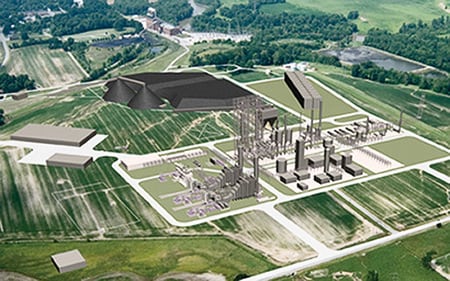
1. Gas attack. An artist’s rendering of Duke Energy’s proposed 795-MW Edwardsport IGCC plant near Vincennes, Ind. The project recently earned the company a tax credit of $133.5 million. Courtesy: Duke Energy
The other four gasification awards went to:
- Tampa Electric’s 789-MW IGCC plant in Polk County, Fla. ($133.5 million).
- Mississippi Power Co.’s 700-MW lignite-fueled IGCC project in Kemper County ($133 million).
- Carson Hydrogen Power LLC, for production of hydrogen and 390 MW of generation from it.
- Texas Energy LLC, for a project in Longview to gasify coal for use as chemical feedstock.
Carson Hydrogen Power and Texas Energy refused to allow the government to publicize the value of their credits. The DOE said, "The names of the tax credit recipients are considered confidential taxpayer information," meaning that disclosure is voluntary.
The other advanced coal award winner was E.ON U.S., which, with its subsidiaries Kentucky Utilities Co. and Louisville Gas & Electric Co., came away with a $125 million tax credit. The deduction will help lower the overall cost of building Trimble County 2, a new 750-MW supercritical pulverized coal-fired unit that is targeting 40% efficiency and top-drawer environmental credentials such as 99% SO2 removal and 90% mercury capture.
In a press release, the DOE said, "Advanced coal technologies face cost, integration, and reliability hurdles that must be overcome if they are to be widely deployed. DOE believes deployment incentives, such as tax credits, will accelerate the widespread use of these technologies and assist in driving down their overall cost." The department said the remaining $650 million of tax credits in the program will be awarded later this year.
The awards caused some distress at North Dakota’s Basin Electric Power Cooperative, which had applied for a tax credit but didn’t get one. Ron Harper, Basin’s CEO, said, "We’re disappointed that the Department of Energy chose not to certify any sub-bituminous clean coal technology projects. We feel that it is critical that the federal government support the commercialization of IGCC technology." Basin Electric has been working with GE Energy, Bechtel, and others on a future project of that genre. Harper said his generation and transmission cooperative will consider applying again for the second round of largesse.
For Swedish nuke, a case of mistaken identity
Swedish utility Vattenfall AB has strongly denied claims made in a November 19 cover story in the German news magazine Der Spiegel that an outage at the Forsmark 1 nuclear power plant (Figure 2) last July was a near-catastrophe. The magazine’s "World on Sunday," attributing its information to the German Society for Plant and Reactor Safety, reported that the 970-MW boiling water reactor in Uppsala came close to a core meltdown and that former Swedish Prime Minister Göran Persson personally gave the order that saved the plant.

2. Forsmark 1. The 970-MW boiling water reactor made its commercial debut in the Vattenfall system in December 1980. ASEA-Atom supplied the reactor. Courtesy: Vattenfall AB
"That is simply not true," said Goran Lundgren, head of Nordic generation for Vattenfall, in a written statement. "Such a danger never existed. I do not understand from where such claims come."
The plant suffered an unplanned outage, or scram, on July 25, as the result of a short circuit, but that event was quickly contained. Lundgren said that the Swedish Nuclear Power Inspectorate (SKI) has confirmed that "there was never any danger of a nuclear meltdown. The level of the cooling water was stable all the time above the two-meter level, and 22 minutes after the short-circuit the feeding of electricity started working again with full effect."
According to Der Spiegel, Persson gave the reactor operators permission to open the "Wallman valve" to relieve pressure in the core. Claes-Inge Anderson, head of information at Forsmark, said that there is no valve of that name. SKI has verified that. Anderson added, "The claim that the prime minister would have been involved is absolutely absurd. All operative decisions are being made by Forsmark."
Vattenfall says there may be a case of mistaken identity here. The production manager of Forsmark 2 also is named Göran Persson. In a press release, Vattenfall said that Forsmark’s Persson participated in the July 25 scram and his name was mentioned in one incident report.
Siemens completes big CHP plant
A new 260-MW combined heat and power plant, the Rya project in Gothenburg (Figure 3), is the largest plant built in Sweden in 20 years, according to Siemens Power Generation (www.powergeneration.siemens.com). The company built the natural gas–fired plant, which overlooks the River Goeta, on a turnkey basis. It was formally commissioned late last year.
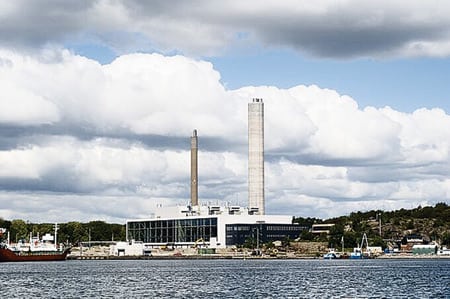
3. Super-efficient. The Rya combined heat and power plant in Gothenburg, Sweden, built by Siemens, is the first large power plant installed in the country in 20 years and (according to the company) 92.5% efficient. Courtesy: Siemens PG
Siemens says the plant’s overall efficiency of 92.5% contributes to its saving 600,000 tons of CO2 emissions per year. The CHP plant will meet about 35% of Gothenburg’s district heating demands and 30% of its power needs.
The Rya project is the city’s largest ever environmental project. The municipal utility hired Siemens PG in January 2004 to provide all civil works, turbines, a single heat-recovery steam generator, erection, commissioning, and performance test. Siemens also will be responsible for servicing the plant for 15 years.
Three 45-MW SGT-800 gas turbines and one 141-MW SST-900 steam turbine anchor the power island. The gas turbines are specially designed for the 3 x 1 x 1 configuration and equipped with low-NOx burners that can handle gas or fuel oil.
E.ON bets big on coal
Germany’s giant electricity and gas utility, E.ON, has launched a companywide technology initiative that includes plans to build what is billed as "the world’s most modern coal-fired power station." The claim is a reference to the COMTES 700 project, which is testing materials for a new ultrasupercritical pulverized coal plant design.
COMTES 700 (www.comtes700.org) is a European Union–funded component testing program installed at E.ON’s Scholven 676-MW coal-fired power plant in Gelsenkirchen, Germany (Figure 4).

4. Ultrasupercritical test. E.ON’s Scholven plant in Germany is the test bed for the COMTES 700 project and the basis for E.ON’s big bet on coal. Courtesy: E.ON
COMTES 700 describes the gist of the test program as "[improving] the efficiency of conventional pulverized coal-fired power plant technology by increasing the major steam parameters and improving the water/steam cycle." Main and reheat steam temperatures are to be raised near 1,300F (roughly 700C, hence the project’s name) to achieve net efficiencies in the range of 50% to 55%. This, of course, assumes the successful development of new—and very costly—nickel-based alloys (super alloys) for the hottest section of the cycle, new austenite for the medium-temperature section (to minimize the use of the super alloys), and new ferrites as well. The project’s premise is that "substantial avoidance of CO2 emissions can be achieved without entailing excessive cost."
The COMTES test program is scheduled to be completed in 2009. In a press release, E.ON said, "As things stand today, E.ON will start building the power station in 2010." Then, said E.ON, would come the tougher task of capturing and sequestering the plant’s CO2 emissions. E.ON also is a partner in the U.S. DOE’s FutureGen project for gasifying coal, generating hydrogen and electricity, and capturing and sequestering CO2.
In addition to its fossil fuel initiatives, E.ON says it also is interested in boosting renewable energy, particularly offshore wind and biogas. E.ON says it will focus on deep-water wind farms, "[which] are particularly challenging in terms of design and materials." The company says it will have 500 MW of wind capacity installed off the German coast by 2011 and the 200-MW Rodsand 2 offshore wind farm in Denmark running by 2010.
According to E.ON, it already has about 700 MW of installed biogas generation, mostly in small plants. The utility says it "sees significant efficiency benefits in the future use of biogas and by feeding the process gas into the gas grid. This will make it possible to use biogas in electricity generation whenever biogas yields the greatest benefit, for example in cogeneration and in condensing boilers used for heat generation."
BP Solar expands Maryland plant
BP Solar has unveiled a $70 million plan to expand its North American headquarters in Frederick, Md. (Figure 5) and nearly double—to 150 MW—the photovoltaic manufacturing capacity of its factory there.
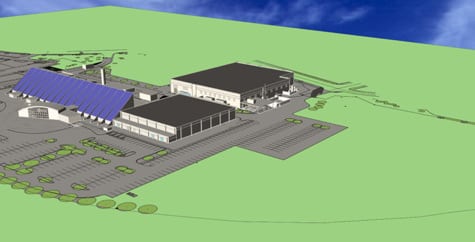
5. Before . . . BP Solar’s Frederick, Md., headquarters and manufacturing plant is already a stunning piece of architecture. Courtesy: BP America
BP says it has completed initial engineering feasibility studies and will now move on to detailed front-end engineering design work. The expansion will make the Frederick operation the largest fully integrated photovoltaic cell manufacturing plant in North America, according to the company. BP says it expects to begin construction in the first quarter of this year and finish by the end of 2008, pending local permit approvals.
The expansion plan calls for construction of 140,000 square feet of new space (Figure 6). BP says that will allow it to nearly double the factory’s casting, sizing, and wafering capacities. Casting and sizing are the initial stages in manufacturing solar cells. Casting involves melting small pieces of silicon and cooling them into an ingot. The ingot is then cut, first into bricks of precise size and then into very thin wafers onto which solar cells can be etched.
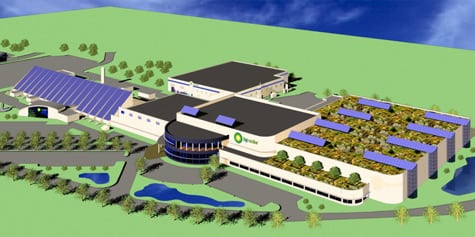
6. . . . and after. The $70 million facility expansion should produce an even more interesting building. Courtesy: BP America
Lee Edwards, CEO of BP Solar, said, "In addition to expanding our manufacturing capacity, our plans are to upgrade the interior of existing facilities and to use sustainable building techniques such as a roof garden, bio-retention, extensive water recycling, and the utilization of LEED [Leadership in Energy and Environmental Design] design components such as energy efficient lighting, heating, and cooling."
The project includes new office and meeting space, more daylight access to office and manufacturing areas, an auditorium, and solar and environmental education stations for tours and school groups, BP said.
In 2004–2005, BP Solar put $25 million into the Frederick facility, expanding its casting and wafering capacity by 30% and doubling its cell and module manufacturing capability. At the end of 2005, the factory had a 40-MW run rate.
GE scores big turbine deals
Two big foreign deals headline this month’s news about GE Energy. The first of three GE Frame 9H gas turbines is being installed at a Tokyo Electric Power Co. (Tepco) power plant under construction, and three 109FB combined-cycle systems will serve as the heart of a big new plant in Algeria.
The Tepco project—Futtsu Thermal Power Station Group 4—will be powered by three GE 109H systems (Figure 7), each comprising a 9H gas turbine, steam turbine, and generator. Together, they will be capable of generating 1,520 MW when the plant goes commercial between 2008 and 2010. The first of the 9H machines was shipped to Japan last June and erected in August.
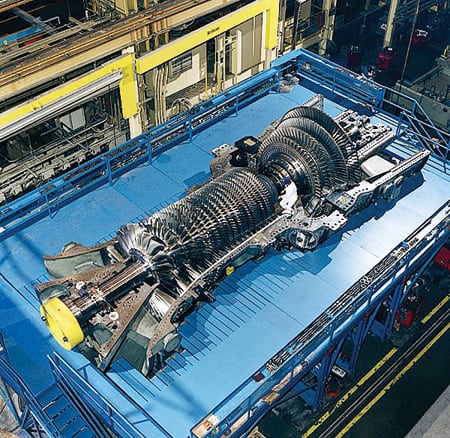
7. Headed to Japan . . . A General Electric 9H turbine identical to one recently installed by Tokyo Electric Power as part of the Futtsu Thermal Power Station Group 4 project. Courtesy: GE
GE notes that the H system, which is making its Asian debut on the Futtsu project, offers both high efficiency and low emissions. According to the company, it "has the capability of producing 87,000 metric tons per year fewer greenhouse gases . . . compared to a typical gas turbine combined-cycle plant producing the equivalent electricity."
In the Algerian deal, GE will supply three 109FB single-shaft combined-cycle systems to SNC-Lavalin Constructors International, a Canadian firm that is building and will operate a new, 1,227-MW plant at Hadjret Ennous. The Frame 9B turbines (Figure 8), which will be fueled by natural gas, represent the latest evolutionary step in GE’s F-class technology line. In addition to supplying the hardware, GE will performance-test the plant when it is finished and provide maintenance support for 20 years.

8. . . . and Algeria. GE also is supplying three 9FB turbines to an Algerian project. Courtesy: GE
The Algerian order, said John Reinker, GE’s general manager of heavy-duty gas turbine and combined-cycle products, "follows an earlier project, where we supplied our FA technology for an 800-MW power plant in the Algerian coastal city of Skikda." That plant entered commercial service in October 2005.
PSNH switches from coal to wood
Public Service of New Hampshire (PSNH) has completed one of the largest renewable energy repowering projects in the U.S. The goal of the $75 million Northern Wood Power Project was to replace an ancient, 50-MW coal-fired boiler at the utility’s Schiller station in Portsmouth with a state-of-the-art wood chip–burning boiler of similar capacity.
The repowering should reduce the plant’s air emissions by more than 380,000 tons annually, according to the utility. "The dramatic emission reductions will help us satisfy the strict requirements of the New Hampshire Clean Power Act," said Gary Long, PSNH president and chief operating officer.
Considered a new renewable energy project, the Northern Wood facility will generate more than 300,000 renewable energy certificates annually. The green certificates can be sold to other regional energy suppliers, and the revenues should offset the project’s capital costs, said PSNH. Construction of the project began in October 2004, following regulatory review by the state and local planning boards in Portsmouth and Newington.
The main components of the plant are a 110-foot-high boiler and a fuel delivery system that uses hydraulic lifts to deliver truckloads of wood chips to the fuel storage area (Figure 9). The storage area can hold about 10,000 tons of wood chips, about one-fortieth the annual capacity of the boiler. Most of the chips will come from the Granite State. PSNH says use of local wood was one of the goals of the project, which was supported by the New Hampshire Timberland Owners’ Association, the Audubon Society of New Hampshire, and the Society for the Protection of New Hampshire Forests.
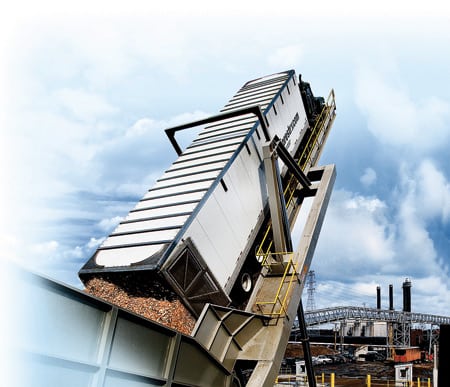
9. Down the hatch. Public Service of New Hampshire’s new wood-burning plant uses hydraulic lifts to dump truckloads of wood chips. Courtesy: PSNH
EPRI tests solid-state current limiter
The Electric Power Research Institute (EPRI) reports that it has successfully tested a prototype design for a solid-state current limiter (SSCL), a device that restricts fault current from new generation or transmission and reduces switching surges (Figure 10). EPRI worked with Consolidated Edison of New York on the project.

10. Zapping the zaps. This strange-looking device restricts fault currents (short circuits and switching surges) that can result when new generation is connected to a grid. Courtesy: EPRI
The SSCL, says EPRI, "restricts fault occurrences when new capacity, such as the additional generation created by independent power producers, is integrated into existing power systems, creating a greater likelihood of fault current." The SSCL absorbs any short circuits and gradually phases in the new current.
"This technology will allow utilities to significantly increase the capability and reliability of their existing power lines," said Arshad Mansoor, EPRI’s vice president of power delivery and markets. Today, the only option utilities have for addressing fault current issues is to uprate their circuit breakers. But that may be uneconomical, or impossible due to space constraints. What’s more, notes EPRI, "breaker replacements alone may not eliminate mechanical and magnetic bracing issues for other equipment that high fault currents pass through."
The SSCL, said Con Edison Technical Specialist Patrick DiLillo, "[has demonstrated its ability] to safely withstand the impact of and limit prospective fault currents. [The] device can be used to mitigate the effects of the increased capacity required to serve increasing loads in our urban centers. We have already begun work to migrate this technology to higher normal current and voltage ratings."
According to EPRI, the next step is to test the SSCL at a host utility "to determine if it is suitable for widespread development."
POWER digest
News items of interest to power industry professionals.
British fuel cells report test results. British fuel cell developer Ceres Power (www.cerespower.com) reports that its fuel cell stacks have passed tests that suggest its technology can meet the demands of the markets it is targeting: combined heat and power, off-grid generation, and auxiliary power units.
The company, formed in 2001 to commercialize fuel cell technology developed at Imperial College over the prior decade, said it has met the following milestones:
- Completion of more than 7,500 hours of fuel cell stack testing.
- Testing of more than 50 stacks of up to 1-kW output with repeated cycling between room temperature (70F) and operating temperatures (1,100F) without performance degradation.
- Testing on a range of commercial fuels, including natural gas, liquefied petroleum gas, and propane.
- More than 1,000 stack subassemblies constructed with a zero failure rate.
Alstom wins big U.S. contracts. French engineering giant Alstom SA has won three contracts worth $513 million to supply pollution control equipment at 10 coal-fired stations in Texas, Kentucky, and South Carolina.
Alstom will provide TXU with equipment for controlling SO2, particulate, and mercury emissions from eight new 858-MW units the utility has planned for Texas. According to Alstom, SO2 emissions from the units will be 80% lower than from the average U.S. coal-fired plant. The plants are scheduled to begin operating in 2009. The contract is worth $359 million.
Alstom also will supply a flue gas scrubber for the 340-MW Unit 1 of East Kentucky Power Cooperative’s H.L. Spurlock Power Station in Maysville, Ky. Alstom earlier won the contract to supply a scrubber for Unit 2. The new contract, which is worth $103 million, anticipates that both scrubbers will be in place and working by 2009.
In South Carolina, working with AMEC and Zachry Construction Corp., Alstom will supply a NOx control system for South Carolina Electric & Gas Co.’s Cope Power Station, an existing 430-MW pulverized coal-fired plant. The deal is valued at $64 million, and Cope is scheduled to be operating with the new gear in January 2009.
Alstom executive Philippe Joubert said, "Coal is really back, particularly in the U.S.
"
Plum Point project fully subscribed. LS Power of St. Louis says it has signed a 30-year power-purchase agreement with Southwestern Electric Cooperative Inc. (SWECI), a distribution cooperative serving 20,000 customers in southwestern Illinois. SWECI will be buying 70 MW of LS Power’s 665-MW Plum Point independent power project in Osceola, Ark.
The SWECI deal closes out the subscription for the Plum Point project. Three public power agencies and one investor-owned utility each have signed on for 30 years of its capacity. The other contracts are with Empire District Electric Co., South Mississippi Electric Power Association, and the Missouri Joint Municipal Electric Utility Commission (MJMEUC).
LS Power broke ground on the pulverized coal-fired plant last March. In addition to the power supply contracts, the company has sold ownership shares to East Texas Electric Cooperative Inc., MJMEUC, Empire District, and the Municipal Energy Agency of Mississippi. The plant is being built by Plum Point Power Partners, a joint venture of Zachry Construction Corp., Black & Veatch, and the Kiewit Construction Co. affiliate Gilbert Central Corp.